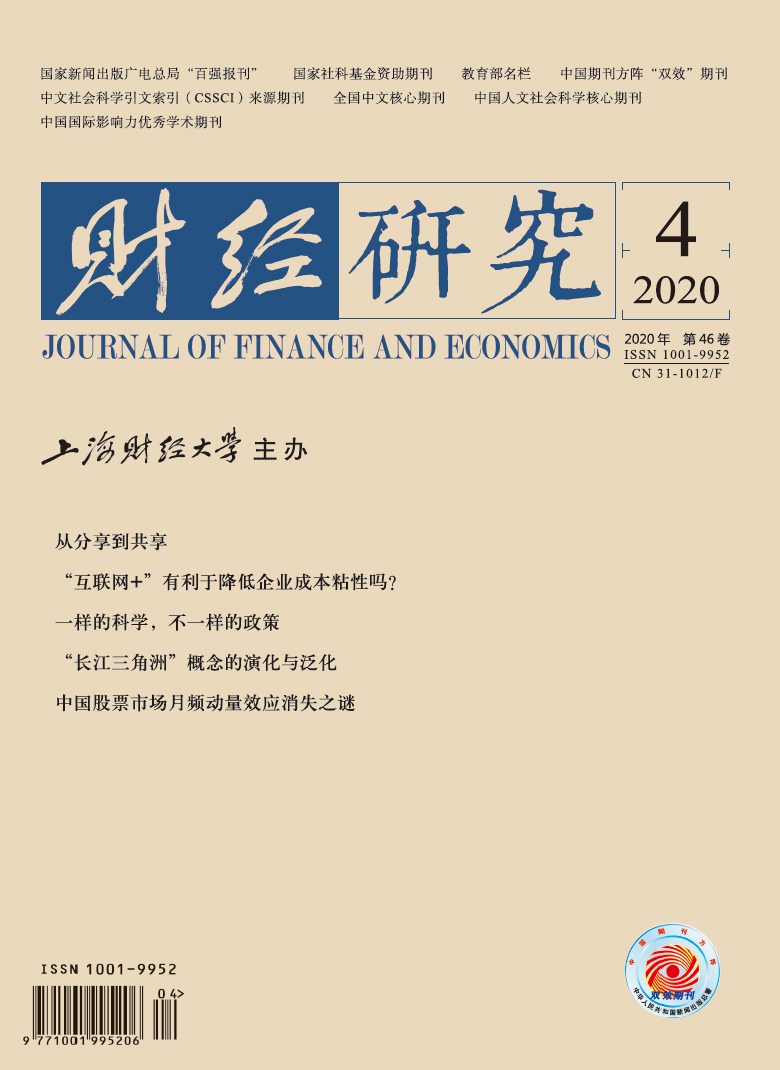文章研究了上证50ETF期权隐含波动率微笑形态中包含的风险信息。实证分析发现,隐含波动率微笑倾斜对股票市场收益有显著的预测能力。隐含波动率微笑倾斜程度越高,未来的股票收益越低。隐含波动率微笑倾斜形态的预测能力在未来12周之内非常稳定,在未来12周到24周之间开始减弱。在更换隐含波动率微笑倾斜程度的测度方法以及加入控制变量后,上述结论仍成立。此外,上证50ETF期权隐含波动率微笑倾斜程度不仅对上证50指数的未来走势有显著的预测能力,而且对其成分股也有显著的定价能力。文章进一步分析了期权隐含波动率水平,发现这一指标能够显著预测上证50指数收益,但对成分股却没有定价能力。这表明与波动率本身相比,期权隐含波动率的微笑倾斜程度是更好的股票风险溢价因子。
上证50ETF期权隐含波动率微笑形态的风险信息容量研究
摘要
参考文献
1 陈国进,许秀,赵向琴. 罕见灾难风险和股市收益−基于我国个股横截面尾部风险的实证分析[J]. 系统工程理论与实践,2015,(9):2186−2199. DOI:10.12011/1000-6788(2015)9-2186
3 刘庞庞. 期权市场对现货市场波动率影响的实证分析−基于上证50ETF期权上市前后的比较[J]. 统计与信息论坛,2017,(10):50−58. DOI:10.3969/j.issn.1007-3116.2017.10.007
4 陆静,裴饴军,吴琴琴. 投资者情绪影响香港股票市场吗?[J]. 系统工程理论与实践,2017,(1):80−90. DOI:10.12011/1000-6788(2017)01-0080-11
5 王鹏,杨兴林. 基于时变波动率与混合对数正态分布的50ETF期权定价[J]. 管理科学,2016,(4):149−160. DOI:10.3969/j.issn.1672-0334.2016.04.013
7 谢尔登·纳坦恩伯格. 期权波动率与定价[M]. 韩冰洁译. 北京: 机械工业出版社, 2014.
9 张静,宋福铁. 上证ETF50期权上市对标的股票的影响−基于流动性和波动性的视角[J]. 金融发展研究,2016,(3):59−65. DOI:10.3969/j.issn.1674-2265.2016.03.010
10 张强,杨淑娥. 噪音交易、投资者情绪波动与股票收益[J]. 系统工程理论与实践,2009,(3):40−47. DOI:10.3321/j.issn:1000-6788.2009.03.007
11 Andersen T G,Fusari N,Todorov V. The pricing of tail risk and the equity premium:Evidence from international option markets[J]. Journal of Business & Economic Statistics,2019. DOI:10.1080/07350015.2018.1564318
12 Bakshi G,Kapadia N,Madan D. Stock return characteristics,skew laws,and the differential pricing of individual equity options[J]. Review of Financial Studies,2003,16(1): 101−143. DOI:10.1093/rfs/16.1.0101
13 Bates D S. The crash of ’87:Was it expected? The evidence from options markets[J]. The Journal of Finance,1991,46(3): 1009−1044. DOI:10.1111/j.1540-6261.1991.tb03775.x
14 Black F,Scholes M. The pricing of options and corporate liabilities[J]. Journal of Political Economy,1973,81(3): 637−654. DOI:10.1086/260062
15 Bollen N P B,Whaley R E. Does net buying pressure affect the shape of implied volatility functions?[J]. The Journal of Finance,2004,59(2): 711−753. DOI:10.1111/j.1540-6261.2004.00647.x
16 Bollerslev T,Todorov V. Tails,fears,and risk premia[J]. The Journal of Finance,2011,66(6): 2165−2211. DOI:10.1111/j.1540-6261.2011.01695.x
17 Chang B Y,Christoffersen P,Jacobs K. Market skewness risk and the cross section of stock returns[J]. Journal of Finan- cial Economics,2013,107(1): 46−68. DOI:10.1016/j.jfineco.2012.07.002
18 Christoffersen P,Heston S,Jacobs K. The shape and term structure of the index option smirk:Why multifactor stochastic volatility models work so well[J]. Management Science,2009,55(12): 1914−1932. DOI:10.1287/mnsc.1090.1065
19 Dennis P,Mayhew S. Risk-neutral skewness:Evidence from stock options[J]. The Journal of Financial and Quantita- tive Analysis,2002,37(3): 471−493. DOI:10.2307/3594989
20 Ding C G,Wang H J,Lee M C,et al. How does the change in investor sentiment over time affect stock returns?[J]. Emerging Markets Finance and Trade,2014,50(S2): 144−158. DOI:10.2753/REE1540-496X5002S210
21 Easley D,O’Hara M,Srinivas P S. Option volume and stock prices:Evidence on where informed traders trade[J]. The Journal of Finance,1998,53(2): 431−465. DOI:10.1111/0022-1082.194060
22 Eraker B,Johannes M,Polson N. The impact of jumps in volatility and returns[J]. The Journal of Finance,2003,58(3): 1269−1300. DOI:10.1111/1540-6261.00566
23 Fama E F,Macbeth J D. Risk,return,and equilibrium:Empirical tests[J]. Journal of Political Economy,1973,81(3): 607−636. DOI:10.1086/260061
24 Foresi S,Wu L R. Crash-o-phobia:A domestic fear or a worldwide concern?[J]. The Journal of Derivatives,2005,13(2): 8−21. DOI:10.3905/jod.2005.605352
25 Gârleanu N,Pedersen L H,Poteshman A M. Demand-based option pricing[J]. The Review of Financial Studies,2009,22(10): 4259−4299. DOI:10.1093/rfs/hhp005
26 Ge L,Lin T C,Pearson N D. Why does the option to stock volume ratio predict stock returns?[J]. Journal of Financial Economics,2016,120(3): 601−622. DOI:10.1016/j.jfineco.2015.08.019
28 Jin W,Livnat J,Zhang Y. Option prices leading equity prices:Do option traders have an information advantage?[J]. Journal of Accounting Research,2012,50(2): 401−432. DOI:10.1111/j.1475-679X.2012.00439.x
29 Johnson T L,So E C. The option to stock volume ratio and future returns[J]. Journal of Financial Economics,2012,106(2): 262−286. DOI:10.1016/j.jfineco.2012.05.008
30 Kelly B,Jiang H. Tail risk and asset prices[J]. The Review of Financial Studies,2014,27(10): 2841−2871. DOI:10.1093/rfs/hhu039
31 Merton R C. Option pricing when underlying stock returns are discontinuous[J]. Journal of Financial Economics,1976,3(1-2): 125−144. DOI:10.1016/0304-405X(76)90022-2
32 Pan J. The jump-risk premia implicit in options:Evidence from an integrated time-series study[J]. Journal of Financial Economics,2002,63(1): 3−50. DOI:10.1016/S0304-405X(01)00088-5
33 Pan J,Poteshman A M. The information in option volume for future stock prices[J]. The Review of Financial Studies,2006,19(3): 871−908. DOI:10.1093/rfs/hhj024
34 Roll R,Schwartz E,Subrahmanyam A. O/S:The relative trading activity in options and stock[J]. Journal of Financial Economics,2010,96(1): 1−17. DOI:10.1016/j.jfineco.2009.11.004
35 Rubinstein M. Nonparametric tests of alternative option pricing models using all reported trades and quotes on the 30 most active CBOE option classes from august 23,1976 through august 31,1978[J]. The Journal of Finance,1985,40(2): 455−480. DOI:10.1111/j.1540-6261.1985.tb04967.x
36 Xing Y H,Zhang X Y,Zhao R. What does the individual option volatility smirk tell us about future equity returns?[J]. The Journal of Financial and Quantitative Analysis,2010,45(3): 641−662. DOI:10.1017/S0022109010000220
37 Yan S. Jump risk,stock returns,and slope of implied volatility smile[J]. Journal of Financial Economics,2011,99(1): 216−233. DOI:10.1016/j.jfineco.2010.08.011
38 Zhang J E,Xiang Y. The implied volatility smirk[J]. Quantitative Finance,2008,8(3): 263−284. DOI:10.1080/14697680601173444
引用本文
倪中新, 郭婧, 王琳玉. 上证50ETF期权隐含波动率微笑形态的风险信息容量研究[J]. 财经研究, 2020, 46(4): 155-169.
导出参考文献,格式为:
上一篇:“一带一路”倡议的进口价格效应





 4884
4884  8712
8712

